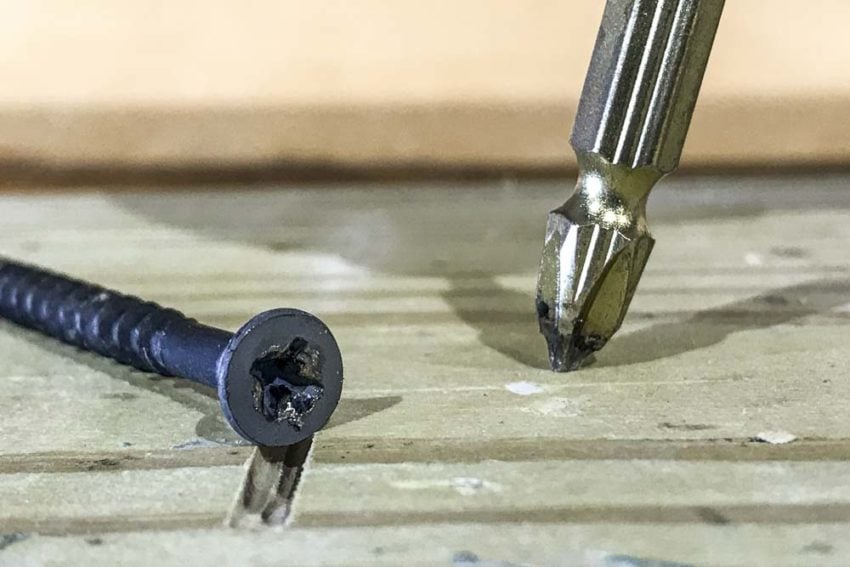Cam out happens when your screwdriver bit slips out of the screw head while turning it. It’s annoying, damages the fastener head or bit, and causes more cursing than most of us would like to admit.
10-Second Summary
- Cam out happens when the bit tip slips out of the fastener head
- The spinning in and out of the fastener recess damages either the head or the bit
- Use the correct size bit for the fastener
- Be sure you’re setting the bit straight into the fastener
- Square head, Torx head, and star head fasteners reduce cam out
- Using a socket or nut driver with hex head fasteners all but eliminates it
What Causes Cam Out?
Camming out a screw, unfortunately, is not particularly uncommon, especially when working with Phillips head screws. These taper in toward the center just like the driver bit tip.

When you pull the trigger on your driver, the spin pushes the insides of the screw, turning it. When you don’t put enough downforce to engage the fastener or you’re working at an angle into it, the torque from your driver can push the bit up and out.
Since drill and impact drivers spin at such high speeds, the bit pushes in and out of the fastener head hundreds of times before you let go of the trigger.
Cheap, soft screws will cam out their heads and make it very difficult to finish the drive or back them out. Sometimes the bit is the softer metal and it starts to round off. Another possibility is that both materials are hard and the bit tip breaks off.
Avoid Camming Out by Using the Correct Bit
One way to keep your bit from camming out of the fastener is to make sure that you’re using the right size bit. Matching the bit to the screw you’re trying to turn makes a world of difference. When you’re checking, set the bit in and give a wiggle. There shouldn’t be much play. If there is, go to the next larger size.
For instance, before you install any screws, check the sizing on the side of the box. If you’re using a #2 Phillips head, you’ll want a #2 Phillips driver. These will fit pretty snugly into the screw. A quality bit and fastener pair barely moves at all.
You’ll also want to check the bit itself. Even with proper use, they wear down and round out over time. A worn bit will cam out easier than a new one.
Maintaining Balance Reduces Cam-out
Keep your bit straight up and down while you’re driving. Any tilting will transfer force to the screw unevenly. This ultimately causes the bit to disengage and cam out.

When it comes to using a handheld screwdriver, there’s a balance between pushing and turning force. Basically, you can push the bit or driver into the screw with some force, but be more careful with the turning. The folks at NBK recommend applying a 70%/30% pushing to turning force ratio.
Switch to a New Screw
There are quite a few bit and fastener styles available that can help avoid cam-out. With more surface area and grip, square, star, and Torx bits and screws avoid stripping out and transfer more torque more easily.
Rather than having a tapered recess and four points of surface area to turn with, the Torx design provides more contact area to grip while maintaining a consistent depth in the head. Cam out with these hexalobular bits is almost impossible as long as you keep the bit heading straight in.

You can also go with a hex head fastener and use a nut driver or socket for many applications. By surrounding the head instead of sliding into it, it’s much easier to keep the pair engaged.

Wrapping Things Up
When it comes to camming out of a screw or fastener, you can experience with any tool. From hand screwdrivers to drills, the idea is to keep positive pressure so the bit stays in place while you drive. With drills you need to apply a lot of force. Impact drivers make this a whole lot easier due to the rotating action of these tools.
In the end, good technique and a properly-fitting fasteners and bits make all the difference.
Like the impact driver from the photo? It’s the Makita XDT16 from our best impact driver head-to-head review. Check out our in-depth review of it here!



